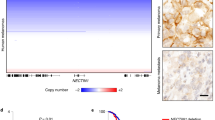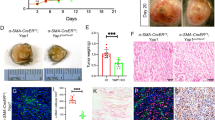Abstract
Malignant transformation of melanocytes frequently coincides with loss of E-cadherin expression. Here, we show that loss of E-cadherin leads to induction of nuclear factor kappa B (NFκB) activity in melanoma cell lines. Melanoma cells show constitutively active NFκB, whereas no activity is found in primary melanocytes. After re-expression of E-cadherin in melanoma cells, strong downregulation of NFκB activity was found. Consistently, NFκB activity was induced in primary human melanocytes after inhibition of E-cadherin activity by functionally blocking anti-E-cadherin antibodies. Interestingly, re-expression of E-cadherin-blocked p38 MAPK activity and the p38 MAPK inhibitors SB203580 and SB202190 almost completely prevented NFκB activation in melanoma cells. Furthermore, cytoplasmatic β-catenin induced p38 and NFκB activation in malignant melanoma. To our knowledge, this is the first report suggesting a correlation between E-cadherin and NFκB activity in melanocytes and melanoma cells. In summary, we conclude that loss of E-cadherin and cytoplasmatic β-catenin induces p38-mediated NFκB activation, potentially revealing an important mechanism of tumorigenesis in malignant melanomas.
This is a preview of subscription content, access via your institution
Access options
Subscribe to this journal
Receive 50 print issues and online access
$259.00 per year
only $5.18 per issue
Buy this article
- Purchase on Springer Link
- Instant access to full article PDF
Prices may be subject to local taxes which are calculated during checkout








Similar content being viewed by others
Abbreviations
- ELISA:
-
enzyme-linked immunosorbent assay
- EMSA:
-
electrophoretic mobility shift assay
- ERK:
-
extracellular signal-regulated protein kinase
- IκB (IkappaB):
-
inhibitor of NFκB
- IL-8:
-
interleukin 8
- JNK:
-
c-jun NH2-terminal kinase
- MAPK:
-
mitogen-activated protein kinase
- Mekk1:
-
MAP kinase kinase1
- MMP2:
-
matrix-metalloproteinase 2
- NFκB:
-
nuclear factor kappa B
- NHEM:
-
normal human epidermal melanocytes
- PBS:
-
phosphate-buffered saline
- PD98059:
-
2-(2′amino-3′-methoxyphenyl)-oxanaphthalen-4-one
- PKB:
-
protein kinase B
- RT:
-
reverse transcription
- SAPK:
-
stress-activated protein kinase
- SB202190:
-
4-(4-fluorophenyl)-2-(4-hydroxyphenyl)-5-(4-pyridyl)1H-imidazole
- SB203580:
-
4-(4-fluorophenyl)-2-(4-methylsulfinylphenyl)-5-(4-pyridyl)1H-imidazole
- TCF:
-
T-cell factor
- TGFβ2:
-
transcriptional growth factor beta 2
References
Baldwin AS . (2001). J. Clin. Invest., 107, 241–246.
Bergmann M, Hart L, Lindsay M, Barnes PJ and Newton R . (1998). J. Biol. Chem., 273, 6607–6610.
Berx G, Cleton-Jansen AM, Nollet F, de Leeuw WJ, van de Vijver M, Cornelisse C and van Roy F . (1995). EMBO J., 14, 6107–6115.
Berx G, Cleton-Jansen AM, Strumane K, de Leeuw WJ, Nollet F, van Roy F and Cornelisse C . (1996). Oncogene, 13, 1919–1925.
Beyaert R, Cuenda A, Vanden Berghe W, Plaisance S, Lee JC, Haegeman G, Cohen P and Fiers W . (1996). EMBO J., 15, 1914–1923.
Bosserhoff AK, Hein R, Bogdahn U and Buettner R . (1996). J. Biol. Chem., 271, 490–495.
Carpentier I, Declercq W, Malinin NL, Wallach D, Fiers W and Beyaert R . (1998). FEBS Lett., 425, 195–198.
Carter AB, Knudtson KL, Monick MM and Hunninghake GW . (1999). J. Biol. Chem., 274, 30858–30863.
Cowin P . (1994). Proc. Natl. Acad. Sci. USA, 91, 10759–10761.
Davis RE, Brown KD, Siebenlist U and Staudt LM . (2001). J. Exp. Med., 194, 1861–1874.
Denkert C, Siegert A, Leclere A, Turzynski A and Hauptmann S . (2002). Clin. Exp. Metast., 19, 79–85.
Englaro W, Bertolotto C, Busca R, Brunet A, Pages G, Ortonne JP and Ballotti R . (1998). J. Biol. Chem., 273, 9966–9970.
Frixen UH, Behrens J, Sachs M, Eberle G, Voss B, Warda A, Lochner D and Birchmeier W . (1991). J. Cell Biol., 113, 173–185.
Gumbiner B, Stevenson B and Grimaldi A . (1988). J. Cell Biol., 107, 1575–1587.
Hellerbrand C, Jobin C, Licato LL, Sartor RB and Brenner DA . (1998). Am. J. Physiol., 275, G269–G278.
Huang S, DeGuzman A, Bucana CD and Fidler IJ . (2000). Clin. Cancer Res., 6, 2573–2581.
Jacob K, Wach F, Holzapfel U, Hein R, Lengyel E, Buettner R and Bosserhoff AK . (1998). Melanoma Res., 8, 211–219.
Kortylewski M, Heinrich PC, Kauffmann ME, Bohm M, MacKiewicz A and Behrmann I . (2001). Biochem. J., 357, 297–303.
Li G, Satyamoorthy K and Herlyn M . (2001). Cancer Res., 61, 3819–3825.
Madrid LV, Mayo MW, Reuther JY and Baldwin Jr AS . (2001). J. Biol. Chem., 276, 18934–18940.
Maulik N, Sato M, Price BD and Das DK . (1998). FEBS Lett., 429, 365–369.
McNulty SE, Tohidian NB and Meyskens Jr FL . (2001). Pigment Cell Res., 14, 456–465.
Melki JR, Vincent PC, Brown RD and Clark SJ . (2000). Blood, 95, 3208–3213.
Nollet F, Berx G and van Roy F . (1999). Mol. Cell Biol. Res. Commun., 2, 77–85.
Novak A and Dedhar S . (1999). Cell Mol. Life Sci., 56, 523–537.
Orsulic S, Huber O, Aberle H, Arnold S and Kemler R . (1999). J. Cell Sci., 112, 1237–1245.
Pece S and Gutkind JS . (2000). J. Biol. Chem., 275, 41227–41233.
Poser I, Dominguez D, de Herreros AG, Varnai A, Buettner R and Bosserhoff AK . (2001). J. Biol. Chem., 276, 24661–24666.
Sanders DS, Blessing K, Hassan GA, Bruton R, Marsden JR and Jankowski J . (1999). Mol. Pathol., 52, 151–157.
Shapiro L, Fannon AM, Kwong PD, Thompson A, Lehmann MS, Grubel G, Legrand JF, Als-Nielsen J, Colman DR and Hendrickson WA . (1995). Nature, 374, 327–337.
Shattuck-Brandt RL and Richmond A . (1997). Cancer Res., 57, 3032–3039.
Silye R, Karayiannakis AJ, Syrigos KN, Poole S, van Noorden S, Batchelor W, Regele H, Sega W, Boesmueller H, Krausz T and Pignatelli M . (1998). J. Pathol., 186, 350–355.
Suh J, Payvandi F, Edelstein LC, Amenta PS, Zong WX, Gelinas C and Rabson AB . (2002). Prostate, 52, 183–200.
Tamura G, Sakata K, Nishizuka S, Maesawa C, Suzuki Y, Iwaya T, Terashima M, Saito K and Satodate R . (1996a). Jpn. J. Cancer Res., 87, 1153–1159.
Tamura S, Shiozaki H, Miyata M, Kadowaki T, Inoue M, Matsui S, Iwazawa T, Takayama T, Takeichi M and Monden M . (1996b). Br. J. Surg., 83, 1608–1614.
Vanden Berghe W, Plaisance S, Boone E, De Bosscher K, Schmitz ML, Fiers W and Haegeman G . (1998). J. Biol. Chem., 273, 3285–3290.
Vleminckx K, Vakaet Jr L, Mareel M, Fiers W and van Roy F . (1991). Cell, 66, 107–119.
Wang D and Richmond A . (2001). J. Biol. Chem., 276, 3650–3659.
Watabe M, Nagafuchi A, Tsukita S and Takeichi M . (1994). J. Cell Biol., 127, 247–256.
Wesselborg S, Bauer MK, Vogt M, Schmitz ML and Schulze-Osthoff K . (1997). J. Biol. Chem., 272, 12422–12429.
Yang J and Richmond A . (2001). Cancer Res., 61, 4901–4909.
Acknowledgements
We are indebted to Astrid Hamm and Claudia Abschlag for technical assistance and to Eric Fearon and Gabriele Handschuh for providing β/-γ-catenin- and pBAT-E-cadherin expression vectors, respectively. We thank Guy Haegeman for helpful discussions. This work was supported by grants from the Deutsche Forschungsgemeinschaft (DFG) to AB.
Author information
Authors and Affiliations
Corresponding author
Rights and permissions
About this article
Cite this article
Kuphal, S., Poser, I., Jobin, C. et al. Loss of E-cadherin leads to upregulation of NFκB activity in malignant melanoma. Oncogene 23, 8509–8519 (2004). https://doi.org/10.1038/sj.onc.1207831
Received:
Revised:
Accepted:
Published:
Issue Date:
DOI: https://doi.org/10.1038/sj.onc.1207831
Keywords
This article is cited by
-
NF-κB signaling in neoplastic transition from epithelial to mesenchymal phenotype
Cell Communication and Signaling (2023)
-
Curcumin: a therapeutic strategy in cancers by inhibiting the canonical WNT/β-catenin pathway
Journal of Experimental & Clinical Cancer Research (2019)
-
HSPD1 repressed E-cadherin expression to promote cell invasion and migration for poor prognosis in oral squamous cell carcinoma
Scientific Reports (2019)
-
Interactions Between the Canonical WNT/Beta-Catenin Pathway and PPAR Gamma on Neuroinflammation, Demyelination, and Remyelination in Multiple Sclerosis
Cellular and Molecular Neurobiology (2018)
-
Aerobic Glycolysis Hypothesis Through WNT/Beta-Catenin Pathway in Exudative Age-Related Macular Degeneration
Journal of Molecular Neuroscience (2017)



